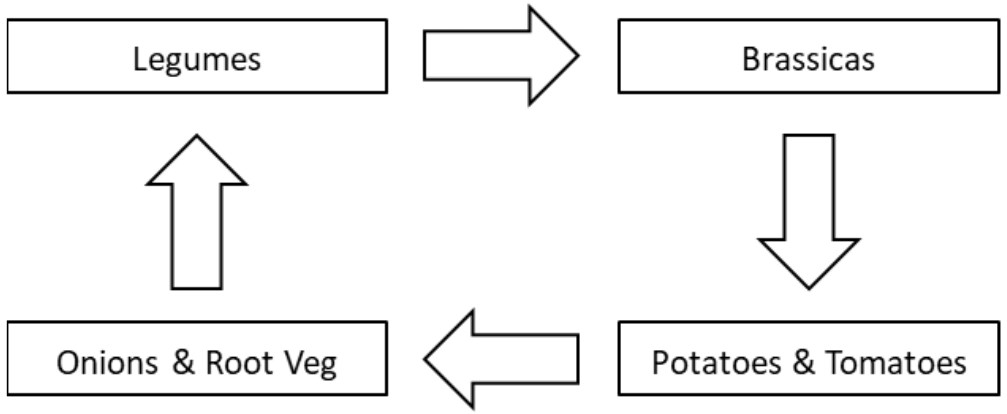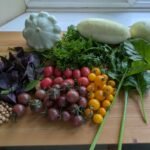What is crop rotation?
Put simply, crop rotation is growing different crops sequentially in the same area. What I’m going to focus on here is a 4-year rotation, as splitting the crops into 4 categories works well. Each category has its own space in the garden, and shifts to another one each year, so by the 5th year everything is back into the plot that it started in.

Before moving on I want to mention plants that are grown out of rotation. Flowers, herbs, squashes, corn, and salad leaves are commonly grown plants that don’t need to go into the regular rotation. If you want to grow these then you can have other section(s) in the garden for them, or plug gaps in your 4-plot rotation with them. Spreading flowers throughout your garden might be a good idea, as they can be very good for attracting pollinators, which you need to pollinate the flowers of some of your food crops in order for you to get fruits from them.
My posts about the individual categories will go into more detail about growing all of these plants and will hopefully help you decide how to ultimately split up your garden. So from now on in this post when I talk about splitting up your garden, it is only with regards to the 4-year rotation part of the garden. Just bear in mind that if you want any of the other plants mentioned, that you will want space for them too, so the 4-year rotation may not take up your entire growing space.
What are the benefits of crop rotation?
Replace soil nutrients
In order to grow, plants use sunlight, water, and ‘food’ in the form of nutrients. This means that any plants you are growing will take nutrients out of the soil. Different plants will use different amounts of each nutrient found in the soil, so by growing the same crop in the same location year after year, you will deplete the soil as you’ll be taking the same nutrients out every year. This is especially bad for plants that are heavy feeders of one nutrient (like brassicas feeding on nitrogen). So rotating crops can give the soil a ‘break’ and a chance to add nutrients back into the soil. Some plants, like legumes, will even add nutrients back into the soil. Legumes do this by converting some of the nitrogen gas from the air into a form that plants can use.
Combat disease
If you plant the same crops in the same location year after year, then diseases can take hold, such as club root in brassicas. However, if you rotate the crops, the disease might not have a host plant the following year and may die, and it will be harder for the disease to take hold. There are a variety of diseases that plants can get, but they usually kill the plant or severely damage it, leading to a loss of crop. There are many ways you can attempt to manage diseases, and this can be used alongside some other methods to give you the best chance of success. This is also a good place to start to try and prevent it easily, naturally, and more passively than other methods.
Fight Pests
Many insects are host-specific, meaning they will only reproduce (and survive) on a specific plant. If you plant the same plants in the same area every year, it makes it easier for insects to find them and can cause a build-up, with them nesting there year after year after year, making it harder and harder to control the pest population. They use smell, taste or sight to identify plants, so moving the plants each year can reduce the number that are able to successfully find the host plants and manage to lay eggs nearby. This can be combined with companion plants, which I will be releasing a blog about soon, to an even greater effect, and leave you better able to manage the pests.
Splitting up the garden
While there are 4 main categories to work with for crop rotation, you can split the garden into 4 or 8 fairly equal sections. Potatoes and tomatoes both go into the same section of a crop rotation plan, but planting them too close to each other can increase the chance of disease.
If you want to grow both tomatoes and potatoes in a crop-rotation, and reduce the chance of disease, then you either need to plant them far enough away from each other within the same plot, or in different plots from each other. 10ft (3m) between the two different plants is the general recommendation, but you could plant them within 2 or 3 ft if you want to try. Just make sure you don’t disturb the tomato roots when you are digging up your potatoes.
I would recommend 4 plots if you:
- Only want to grow either potatoes or tomatoes
- Only want to grow either potatoes or tomatoes in a given year
- If you have space within 1 plot to grow both tomatoes and potatoes while keeping them apart
I would recommend 8 plots if you:
- Want to grow both potatoes and tomatoes, and would rather keep them separate
- Want to grow both potatoes and tomatoes, and don’t have the space to keep them apart in the same plot
If you split the growing area into 8, I’d recommend labelling them A1, A1, B1, B2, C1, C2, D1, D2 or similar, keeping with the 4 categories.
How to rotate crops
A 4-year crop rotation is likely to be the best, provided you will be wanting to grow at least some crops from each category.
The four categories are: legumes, brassicas, nightshades, onions & roots.
Legumes, which includes the varieties of beans and peas. Peanuts are included here, but like peppers, they will probably benefit from being grown in a pot or greenhouse.
Brassicas, which includes brussels sprouts, cauliflower, cabbage, broccoli, calabrese, kale, radish, mustard, swede, turnip.
Nightshades, which includes potatoes and tomatoes. Aubergine and peppers are also in this family, but can be grown anywhere in rotation, and might benefit from being grown in pots or a greenhouse anyway.
Onions and roots, which includes onion, garlic, leek, beetroot, carrots, celeriac, celery, salsify, parsnips.
Plots in rotation
Brassicas follow legumes because brassicas are heavy nitrogen feeders and legumes can add nitrogen to the soil, providing plenty of nutrients for the brassicas the following year. Onions & roots are last in the rotation because root vegetables don’t particularly like soil heavy in nutrients, and it will lead to a lot of leaf growth rather than the root itself (which is the main edible part). Legumes follow onions & roots as the roots break up the soil which is good for legumes.
Plot A – Year 1 is legumes, followed by brassicas in year 2, nightshades in year 3, and onions & roots in year 4, and then going back to legumes in year 5.
This order follows in every plot in the garden, just with each plot being 1 year behind plot A. Meaning:
Plot B is brassicas in year 1, nightshades in year 2, onions & roots in year 3, and legumes in year 4, going back to brassicas in year 5.
Plot C is nightshades in year 1, onions & roots in year 2, legumes in year 3, and brassicas in year 4, going back to nightshades in year 5.
Plot D is onions & roots in year 1, legumes in year 2, brassicas in year 3, and potatoes in year 4, going back to onions & roots in year 5.
Which plants don’t go in the standard rotation?
There are some commonly grown plants that don’t need to go into a set rotation like the other plants that I’ve already mentioned. This includes plants in the squash family, corn, salad leaves, herbs, ‘berries’, flowers, and perennial vegetables like rhubarb and asparagus. Many of the annual plants within these categories will still benefit from being grown in a different position each year, or at least every few years.
What if you don’t want to grow crops from every category?
If you don’t want to grow crops from some categories, or not enough to fill that plot, then you can plant something else in that plot that year, like the plants that don’t need to be in a rotation plan. I would recommend if you aren’t filling a plot with legumes, that you add nitrogen to the soil in other ways, such as growing a green manure in autumn and cutting it down in winter and digging it into the soil. You may want to do this anyway, but it’s especially important if you aren’t growing legumes. Another way you can add nitrogen is through fertiliser. I will be writing a blog about how to easily make a nitrogen fertiliser that can be added to the garden. Again, this is something you may want to do anyway, but it will be especially important if you aren’t growing legumes.
I am proud to be affiliated with JustSeed, a company that I have bought seeds from for a few years now. I believe in what they are doing over there, and if you are going to buy seeds, garden tools, or seedlings, then please consider checking them out and using my link below to do so. Thank you for supporting me.





Leave a Reply